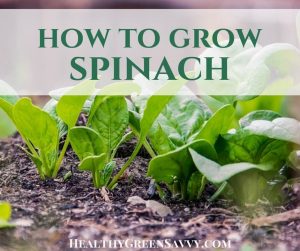Last Updated on February 14, 2025
Find out how to grow spinach to make the most of cool weather growing. Spinach is a quick and nutritious crop for your spring or fall garden!

Do you have a favorite spring crop? Those first few pops of green in the garden — even if they’re just edible weeds — after a long, cold winter are always so thrilling. Spring spinach is right up there for me, those little green sprouts announcing all the delicious things a new season’s growing will bring.
Even if you don’t get weirdly excited about garden veggies, there’s good reason to sow plenty of spinach in your garden this season, both early and late. Aside from the fact that there’s not a lot that will grow when it’s still cold, spinach is so nutritious and versatile, you’ll be really glad you planted lots of it.
So why should you be growing spinach? It’s easy, tasty, versatile, and so good for you!
Spinach is a terrific source of numerous vitamins and minerals, like magnesium, iron, vitamin K, B vitamins and more. Most of us don’t get enough greens in our diets, and spinach’s mild flavor makes it a great veggie to “sneak” into your favorite recipes, from smoothies to soups. Here’s a HUGE collection of delicious and healthy smoothie recipes if you need some inspiration!
Spinach can be added to egg dishes or sauteed and used in pasta recipes. (Here’s my favorite spring recipe using spinach, asparagus and spring garlic, though it also works great without the asparagus.)
You can even make delicate chips out of spinach when you run low on kale chips!
Note that like kale, spinach is rich in oxalates, which can interfere with mineral absorption. Cooking decreases oxalate content, though, so just make sure you’re not eating huge quantities of spinach raw.

Spinach is also a snap to preserve, either in the freezer or the dehydrator. Surplus spinach can wind up in the freezer for nourishing winter meal, or get dehydrated to make a nutritious greens powder for smoothies, soups, and more. (More info below.)
It’s also among the fastest growing vegetables you can plant.
OK, ready to find out how to grow spinach and add some to your planting plans?
How to Grow Spinach: Selecting Seeds
Spinach is usually grown from seed because it doesn’t transplant well. Like a lot of spring greens, it matures quickly, and you can harvest baby leaves in a matter of weeks.
Note that while people tend to think of spinach as a spring crop, it’s even more delicious in the fall when frost has had chance to concentrates its sugars. When it’s had a good frost, you might find yourself eating it plain, it’s so good! The fall crop also tends to produce better. So save some of your spinach seeds for a fall planting.
There are 3 types of spinach: Savoy, semi-savoy, and smooth leaf. Savoy has crinkly leaves and grows close to the ground, so it can be harder to clean than smooth-leaf varieties. But it’s also more disease-resistant and cold-tolerant and has a pleasantly chewy texture. Semi-savoy varieties are more upright and less crinkly and most varieties have good disease and bolt resistance.
Choose your spinach variety according to your priorities, ease of cleaning, harvest timing, or disease resistance. You’ll see many varieties with “winter” in their name, indicating good cold tolerance. For spring or warm climate planting, choose bolt-resistant types. You’ll find loads of options at the seed companies below.
Some spinach varieties to try:
- ‘Bloomsdale’: A commonly available variety. This savoy spinach does well in cool weather but bolts easily. A good choice if you plant very early in spring or for fall plantings.
- ‘Tyee’ and ‘Teton’: Semi-savoy types with good resistance to bolting and downy mildew.
- ‘Space’: Smooth-leaf type that resists downy mildew.
–> In warm weather and climates, try an alternative to spinach. Some plants like amaranth and lambsquarters (also called wild spinach) can work like spinach in the kitchen. (Try them in these amaranth leaves recipes or lambs quarter recipes.
Perpetual spinach chard (Beta vulgaris ssp cicla) can also handle the heat. A plant known as New Zealand spinach (Tetragonia tetragonioides) can be used fresh, but isn’t recommended for cooking.
A perennial vine called Malabar spinach (Basella rubra) is a popular replacement for spinach in warmer climates, or consider Egyptian Spinach, which you can find more about at Green Talk.
I’m a big fan of Seed Savers Exchange. I also sometimes buy Fedco, Johnny’s, and Seeds of Change. You can purchase them online or look for them in your favorite garden store. Botanical Interests also sells many types of spinach worth checking out.
How to Grow Spinach: Planting
Timing is important when growing spinach. If you’re planting spinach in spring, you need a good six weeks for the plant to reach maturity before days get longer and warmer, which will cause the plant to bolt. You want to get your seeds in the ground as soon as the soil has thawed.
You can get a jump on the growing season by preparing your bed in fall, so in spring you just need to poke the seeds in the soil. You can also lay some black plastic over your bed in the spring to warm it and protect it from snow.
Spinach plants prefer cool weather, so in colder climates, planting happens in early spring. In warm climates, spinach needs to be planted in late fall for a winter crop, and depending on how cold it gets, may need some protection like a cloche or cold frame.
Spinach is also one of the 40+ vegetables that grow in shade. Good to know if you’re dealing with shadier conditions.
Seeding: I generally don’t hold with the overplanting and thinning school of gardening, which I think is a waste of seeds and time. But in the case of spinach, where temperatures can sometimes cause problems for germination, it makes sense to plant a little more thickly and eat the thinnings, especially with fall plantings when the soil warmth cuts germination rates.
Seeds don’t cost much, spinach seeds don’t store well, and not having a spinach crop would be sad indeed!

Soil: Spinach likes rich, well-drained soil. Incorporate compost to give your plants critical nutrients and enhance microbial activity. Loosen the soil down about a foot to give spinach’s taproot a chance to dig deep.
Avoid planting where spinach and its relatives (like chard and beets) have grown recently to reduce the chance for disease spreading. Best not to plant near cucumbers either, as spinach can catch blight from them. Planting radishes nearby can help if you have problems with leaf miners.
Follow directions on the seed packet for planting depth and spacing. Give your plants plenty of room to help them resist bolting and disease and help them grow bigger.
I like to use raised beds, where the soil remains looser because no one walks on it. Here are some easy to assemble raised beds that even the not-so-handy can get going in their yards without too much effort.
Mulch well to keep soil moist, which will help keep your spinach from bolting.
Sun: Spinach will do better in full sun but can tolerate a little shade if you have parts of the garden that don’t get as much light.
When the weather’s too cold, you can also grow spinach inside. Here’s what to know about how to grow vegetables indoors.
How to Grow Spinach: Harvesting
If you’re impatient for some fresh food from your garden, you can harvest spinach when leaves are small. You can cut the whole plant with a sharp knife and allow it to regrow, or you can harvest individual larger leaves and let smaller ones continue to grow.
Always harvest spinach early in the day, when leaves have the highest moisture content. It will taste and store better than leaves harvested later in the day.
With savoy or semi-savoy varieties, take care to remove dirt and bugs. Submerge your spinach in a bowl of water to remove soil and insects then dump the water back in the garden — you don’t want to send those valuable nutrients down the drain!
You can prolong the storage time of your spinach if you dry it well and keep it in an airtight container.

Preserving Your Spinach Harvest
Spinach is very easy to preserve for later use, either in the the freezer or as a dehydrated powder.
Freezing Spinach:
Spinach lasts best if it’s cooked briefly before heading to the freezer. Lots of recipes call for blanching, but you’re going to be trying to remove all the excess water you can, so it makes more sense to wilt it briefly in a dry pan. When it’s just wilted, turn off the heat and allow to cool, then squeeze out the excess water to form little balls ready to be tossed into winter soups. A whole pan of spinach will cook down into a couple racquetball-size clumps. You can save the liquid you squeeze to add to your next pot of soup.
Here’s more about how to freeze spinach two ways.
Dehydrating Spinach:
If you haven’t yet gotten into preserving, dehydrating is the perfect place to start, requiring minimal equipment and no expertise. Drying spinach is as easy as laying it on the dehydrator trays and switching it on. The thin leaves will dry at a low temperature in 8-24 hours, depending on what you use to dehydrate. Here’s more information on dehydrating food if you’re curious about this easy way to put up tons of food with little work.
If your soil’s ready, it’s time to grab those spinach seeds and get planting!
If you’re looking for more garden inspiration, check out some of my favorite garden crops:
- How to Grow Spaghetti Squash
- How to Grow Garlic
- How to Grow Cabbage
- How to Grow Melons in Cool Climates
- 9 Ways to Grow Food in a Small Garden
- How to Grow Rhubarb
- Edible Landscaping 101: Growing Fruit
Pin to save these instructions on how to grow spinach for later!

How to grow spinach photo credits: Devanth, kkolosov, ThiloBecker, Deyan Georgiev, bhofack2

Susannah is a proud garden geek and energy nerd who loves healthy food and natural remedies. Her work has appeared in Mother Earth Living, Ensia, Northern Gardener, Sierra, and on numerous websites. Her first book, Everything Elderberry, released in September 2020 and has been a #1 new release in holistic medicine, naturopathy, herb gardening, and other categories. Find out more and grab your copy here.




 Hi, I'm Susannah, a garden geek, energy nerd, and fan of healthy food and natural remedies. Need some simple, practical solutions for living healthier and greener? You've come to the right place! More about me and my green projects
Hi, I'm Susannah, a garden geek, energy nerd, and fan of healthy food and natural remedies. Need some simple, practical solutions for living healthier and greener? You've come to the right place! More about me and my green projects